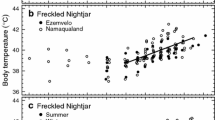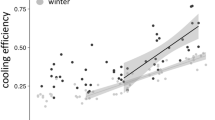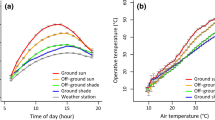Summary
We measured meteorological conditions and estimated the energy costs of thermoregulation for young and adult Adélie Penguins (Pygoscelis adeliae) at a breeding colony near the Antarctic Peninsula. Air temperatures averaged < 5°C and strong winds were frequent. Operative temperatures (Te) for adults ranged from −8 to 28°C, averaging 5–6°C, for the period from courtship to fledging of chicks. The average energy cost of thermoregulation (Cth) for adult penguins was equivalent to 10–16% of basal metabolism. Cth comprised about 15% of the estimated daily energy budget (DEB) of incubating adults, but only about 1% of the DEB of adults feeding chicks. The Te's for chicks older than 14 days ranged from 0 to 31°C, averaging 8.0 C. The Cth for downy chicks ranged from about 31% of minimal metabolic rate (MMR) in 1 kg chicks to about 10% of MMR in 3 kg chicks. Between initial thermal independence (age 12–14 days) and the cessation of parental feeding (age 35–40 days), chicks use about 10–11% of assimilated energy for thermoregulation. Cth is equivalent to about 17% of the MMR of fledglings during their 2–3 week fast. We observed no indication of thermal stress (i.e., conditions in which birds cannot maintain stable Tb) in adults and no indication of cold stress in any age class. However, on clear, calm days when air temperature exceeds 7–10°C for several hours, downy chicks are vulnerable to lethal hyperthermia.
Similar content being viewed by others
References
Adams NJ, Brown CR, Nagy KA (1986) Energy expenditures of free-ranging Wandering Albatross Diomedia exulans. Physiol Zool 59:583–591
Ainley DG, LeResche RE, Sladen WJL (1983) Breeding biology of the Adélie Penguin. University of California Press, Berkeley, p 240
Bakken GS (1976) A heat-transfer analysis of animals: unifying concepts and the application of metabolism chamber data to field ecology. J Theor Biol 60:337–384
Chappell MA, Bartholomew GA (1981) Standard operative temperatures and thermal energetics of the Antelope Ground Squirrel Ammospermophilus leucurus. Physiol Zool 54:81–93
Chappell MA, Souza SL (1988) Thermoregulation, gas exchange, and ventilation in Adélie Penguins (Pygoscelis adeliae). J Comp Physiol 157B:783–790
Chappell MA, Goldstein DL, Winkler DW (1984) Oxygen consumption, evaporative water loss, and temperature regulation of California Gull chicks (Larus californicus) in a desert rookery. Physiol Zool 57:204–214
Chappell MA, Morgan KR, Souza SL, Bucher TL (1989) Convection and thermoregulation in two Antarctic seabirds. J Comp Physiol 159 B:313–322
Croxall JP, Ricketts C (1983) Energy cost of incubation in Wandering Albatross Diomedia exulans. Ibis 125:33–39
Culik B (1989) in situ heart rate and activity of incubating Adélie penguins (Pygoscelis adeliae). Polar Biol 9:365–370
Davis RW, Kooyman GL, Croxall JP (1983) Water flux and estimated metabolism of free-ranging Gentoo and Macaroni Penguins at South Georgia. Polar Biol 2:41–46
Drent RH, Stonehouse B (1971) Thermoregulatory response of the Peruvian Penguin, Spheniscus humboldti. Comp Biochem Physiol 40A:689–710
Goldstein DL (1983) The effect of wind on avian metabolic rates, with particular reference to Gambell's Quail. Physiol Zool 56:485–494
Le Maho Y, Delclitte P, Chatonnet J (1976) Thermoregulation in fasting Emperor Penguins under natural conditions. Am J Physiol 213:913–922
Mitchell JW (1976) Heat transfer from spheres and other animal forms. Biophys J 16:561–569
Monteith JL (1973) Principles of environmental physics. Elservier, New York
Murrish DE (1973) Respiratory heat and water exchange in penguins. Resp Physiol 19:262–270
Murrish DE (1982) Acid-base balance in three species of Antarctic penguins exposed to thermal stress. Physiol Zool 55:137–143
Murrish DE (1983) Acid-base balance in penguin chicks exposed to thermal stress. Physiol Zool 56:335–339
Myrcha A, Kaminski P (1982) Changes in body calorific values during nestling development of penguins of the genus Pygoscelis. Pol Polar Res 3:81–88
Nagy KA, Siegfried WR, Wilson RP (1984) Energy utilization by free-ranging Jackass Penguins, Spheniscus demersus. Ecology 65:1648–1655
Pinshow B, Fedak MA, Battles DR, Schmidt-Nielsen K (1976) Energy expenditure for thermoregulation and locomotion in Emperor Penguins. Am J Physiol 231:903–912
Prince PA, Ricketts C, Thomas G (1981) Weight loss in incubating albatross and its implications for their energy and food requirements. Condor 83:238–242
Robinson DE, Campbell GS, King JR (1976) An evaluation of heat exchange in small birds. J Comp Physiol 105:153–166
Stahel CD, Nicol SC, Walker GJ (1987) Heat production and thermal resistance in the Little Penguin Eudyptula minor in relation to wind speed. Physiol Zool 60:413–423
Stonehouse B (1967) The general biology and thermal balances of penguins. Cragg JB, ed; Advances in Ecological Research, Academic Press, London, pp 131–196
Taylor RH (1961) Some adaptations to cold in penguins. Antarctic, Wellington 2:458–459
Taylor JRE (1985) Ontogeny of thermoregulation and energy metabolism in Pygoscelid penguin chicks. J Comp Physiol 155B:615–628
Taylor JRE (1986) Thermal insulation of the down and feathers of Pygoscelid penguin chicks and the unique properties of penguin feathers. Auk 103:160–168
Trivelpiece WZ, Trivelpiece SG, Volkman NJ (1987) Ecological segregation of Adélie, Gentoo, and Chinstrap Penguins at King George Island, Antarctica. Ecology 68:351–361
Yeates GW (1975) Microclimate, climate and breeding success in Antarctic penguins. Stonehouse B, ed., The Biology of Penguins, MacMillan Press, London, pp 397–409
Author information
Authors and Affiliations
Rights and permissions
About this article
Cite this article
Chappell, M.A., Morgan, K.R. & Bucher, T.L. Weather, microclimate, and energy costs of thermoregulation for breeding Adélie Penguins. Oecologia 83, 420–426 (1990). https://doi.org/10.1007/BF00317570
Received:
Accepted:
Issue Date:
DOI: https://doi.org/10.1007/BF00317570




